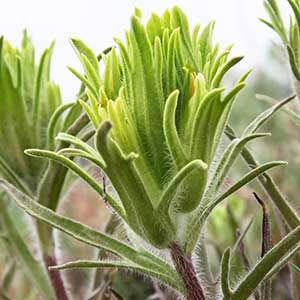Castilleja nelsonii
Castilleja oresbia
Arizona or southern mountains paintbrush, Rincon Mountain Indian paintbrush
pale paintbrush, pale Wallowa Indian paintbrush, pale Wallowa paintbrush
few to many, ascending to erect, unbranched or often strongly and diffusely branched distally, hairs sparse to dense, spreading to matted, long proximally on stem, becoming puberulent distally, ± stiff, eglandular, often mixed with retrorse shorter ones.
few to several, erect or ascending, sometimes decumbent at base, unbranched or branched, hairs usually retrorse, medium length, ± soft, eglandular, mixed with very short-glandular ones, sometimes with spreading, long, soft ones.
green, linear-lanceolate or narrowly to broadly lanceolate, 2–6.5(–8) cm, not fleshy, margins plane, flat to involute, 0(–3)-lobed, apex acute;
lobes ascending, lanceolate, apex acute to obtuse.
green to purple, linear to lanceolate, 2–7 cm, not fleshy, margins plane, involute, 3–5(–7)-lobed, apex acuminate to acute;
lobes spreading, linear to sometimes narrowly lanceolate, apex acute.
(2.5–)5–15 × 2–4.5 cm;
bracts proximally greenish, distally scarlet to red or orange-red, rarely yellow or crimson, veins usually yellow or yellow-green, contrasting conspicuously with base color, lanceolate or elliptic to oblanceolate or obovate, 0–3(–5)-lobed;
lobes ascending, lanceolate to triangular, medium length, arising above mid length, apex rounded to obtuse.
2.5–18 × 1–3.5 cm;
bracts pale green to yellow-green or pale, dull reddish brown throughout, or proximally so colored but changing gradually to cream or yellowish on distal margins, narrowly to broadly lanceolate, (3–)5–7(–9)-lobed;
lobes ascending, linear, long, proximal lobes arising below mid length, central lobe apex obtuse, others acute.
slightly curved, 15–35 mm, subequal to calyx or beak partially to strongly exserted;
tube 15–17 mm;
beak adaxially yellowish green, 10–16 mm;
abaxial lip green, reduced, ± pouched, 0.5–1.5 mm, 4–10% as long as beak;
teeth incurved, deep green, 0.7–1 mm.
straight, 21–36 mm;
tube 16–20 mm;
teeth of abaxial lip often exserted, beak exserted;
beak adaxially green, 4.2–5.5 mm;
abaxial lip green to purple, distally white, conspicuous, slightly but noticeably pouched, often visible through front cleft, 3–5 mm, 67–100% as long as beak, puberulent;
teeth erect, white, 1.8–2.1 mm.
mostly yellowish throughout, with a thin reddish apex, 15–27 mm;
abaxial clefts (5–)9–11 mm, adaxial 4.5–9.5 mm, clefts 25–50% of calyx length, deeper than laterals, lateral 2–4 mm, 10–20% of calyx length;
lobes linear-lanceolate to triangular, apex acute to acuminate, rarely ± obtuse.
colored as bracts, 10–25 mm;
abaxial and adaxial clefts 6–7 mm, 30–60% of calyx length, deeper than laterals, lateral 5–10 mm, 40–50% of calyx length;
lobes linear, apex acute.
= 24.
Castilleja nelsonii
Castilleja oresbia
Castilleja nelsonii is fairly common in the upper elevations of the so-called sky island ranges from central and eastern Arizona to adjacent New Mexico, southward into the Sierra Madre Occidental, at least as far south as southern Chihuahua, where the type collection was obtained on Cerro Mohinora. Although it was long known in the United States as C. austromontana, the name C. nelsonii has priority. Some specimens from southern Coconino County, Arizona, approach C. miniata, but most material is easily separable. Castilleja nelsonii occasionally hybridizes with C. mogollonica in Apache County, Arizona, near the border of the range of the former.
(Discussion copyrighted by Flora of North America; reprinted with permission.)
Castilleja oresbia is endemic to eastern Oregon and adjacent Idaho. It is easily confused with both varieties of C. pallescens, which also occur in sagebrush habitats. Castilleja oresbia has longer calyx lobes and softer pubescence than C. pallescens var. pallescens, although some transitional specimens are found. Castilleja oresbia has a combination of longer calyx lobes, longer pubescence, and obscurely nerved bracts, which usually serve to separate it from C. pallescens var. inverta. All three have different, though somewhat overlapping, ranges. Castilleja oresbia occasionally hybridizes with C. peckiana in Grant County, Oregon.
(Discussion copyrighted by Flora of North America; reprinted with permission.)


